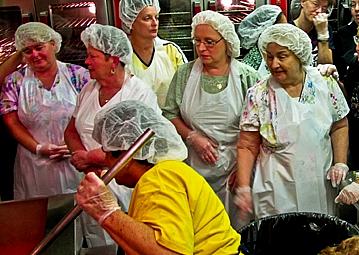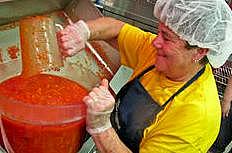W.Va. School Cooks Learn New Tricks
This story is part of Kate Long's fellowship project where she explores West Virginia's epidemics of chronic disease and obesity and the efforts to reverse them. The series is called "The Shape We're In."


ONA, W.Va. -- Eighty cooks from 15 counties packed the Cabell Midland High School kitchen for healthy-cooking boot camp Tuesday and Wednesday.
"Superintendent [Jorea] Marple is absolutely serious about making West Virginia's school meals healthier," said Kristy Blower, a coordinator with the state Office of Child Nutrition. "We're training 80 more cooks in July, then we'll put on more workshops in the fall."
In many speeches this year, Marple has made it clear that, as she told the Gazette, "The schools have a role in fighting our state's obesity crisis, and research clearly tells us that well-nourished children do better in school."
Cabell County's veteran school cooks showed them how to make more nutritious tomato sauce by mixing five vegetables into it: onions, carrots, tomatoes and two kinds of squash.
"The kids never suspect they're eating squash," said veteran cook Alice Gue.
The cooks showed their colleagues how to use industrial cooking equipment -- wedgers, cutters and blitzers -- to easily process hundreds of pounds of potatoes, vegetables and fruit. They cooked hundreds of seasoned chicken breasts and hoagies and made their own Caesar salad, croutons and three kinds of homemade dressing.
"We're loving it," said Lisa Denison, food service director for Pocahontas County. "It's amazing that the state is bringing all these cooks together to empower them to do what cooks all over this state used to do: cook real food that's good for kids."
"The Cabell cooks are showing us we can do it, that it's possible, not just talk," said Charlene Strahan, Preston County food service director.
They studied model menus and price lists and found that it's cheaper to cook from scratch than it is to buy processed, packaged food.
In one corner of the kitchen, Gue presided over a huge vat of tomato vegetable sauce. In 2009, she attracted national attention as Jamie Oliver's nemesis after the British cook landed on Cabell County, vowing to whip the county into healthier, skinnier shape.
"I had a big mouth then, and my mouth is just as big now," Gue said, prompting a big laugh.
"Jamie Oliver cruised in and out when the cameras were there," she said, but he never acknowledged that Cabell County food service director Rhonda McCoy had already started the ball rolling. When Oliver arrived, she said, Cabell County already had salad bars; junk food and soda pop sales were banned from the schools.
"Jamie speeded things up," Gue said, "but the ones who really helped us were his behind-the-scenes cooks. They were great. They stayed with us three months and showed us all kinds of tricks for saving time and making the food more nutritious. Now we're passing them on."
Blower said the state is writing grants to buy kitchen equipment to make scratch cooking easier, "and the schools that come to these workshops will have priority."
Boone, Braxton, Harrison, Logan, Monroe, Nicholas, Pocahontas, Preston, Putnam, Roane, Taylor, Tucker, Upshur, and Wyoming counties also sent cooks to Wednesday's session.
The cooks who attended the workshops will go home and put on workshops for the cooks who could not attend, Fowler said. "The ripples will spread," she said.
Tasty school vegetable/tomato sauce (makes 4 gallons)
2.5 pounds of onions
1 pound of chopped carrots
1 pound butternut squash
1 pound zucchini or summer squash
5 No. 10 cans of diced tomatoes
1 tablespoon table salt
1/2 teaspoon black pepper (or red pepper if desired)
Oregano and other spices, to taste
CHOP squashes and onions fine in food processor. Saute in olive oil. Blend the diced tomatoes to desired consistency, then mix with the sauteing vegetables. Add spices and cook 5 minutes. Blend sauce to desired consistency. Use or freeze. Stays fresh in refrigerator for 7 days.
This article was originally published on The Charleston Gazette

